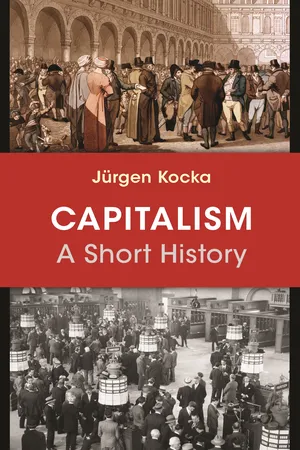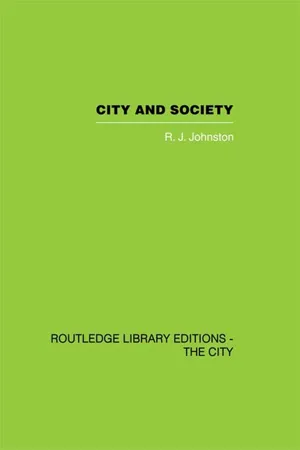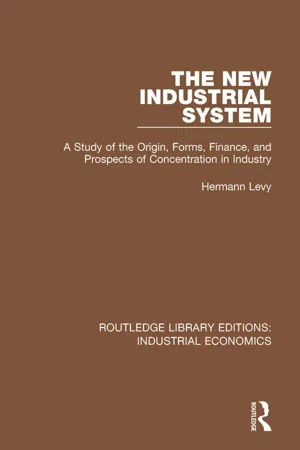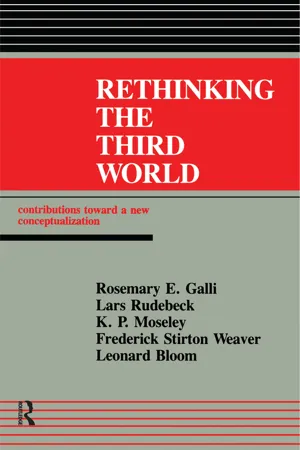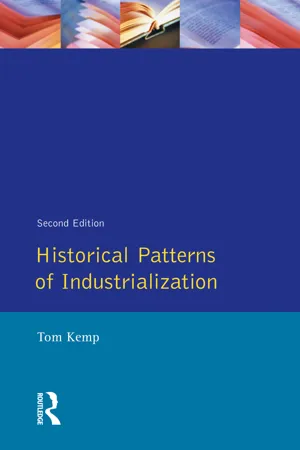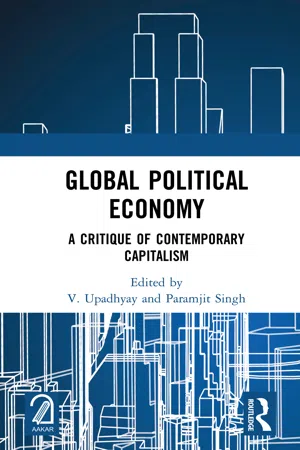History
Industrial Capitalism
Industrial capitalism refers to an economic system characterized by the use of machinery and the concentration of industries in the hands of a few. It emerged during the Industrial Revolution and led to significant changes in production, labor, and society. Industrial capitalism is marked by the pursuit of profit, wage labor, and the commodification of goods and services.
Written by Perlego with AI-assistance
Related key terms
Related key terms
1 of 4
Related key terms
1 of 3
11 Key excerpts on "Industrial Capitalism"
- eBook - ePub
Sociology, Work and Organisation
Seventh Edition
- Tony Watson(Author)
- 2017(Publication Date)
- Routledge(Publisher)
Chapter 1 . Changes in the way work is organised and experienced have been at the heart of the social and historical shifts with which sociology has always engaged. The most significant historical shift identified by sociologists was the rise of technology-based industrialism and capitalist forms of political economy. But, within this, sociologists and other social commentators have identified a variety of subsequent shifts in how the working aspects of societies are organised, using terminology like post-industrialism, post-Fordism, postmodernism and globalisation. Most recently, there has been speculation about a forthcoming fourth industrial revolution.These shifts, or alleged shifts, cannot be understood without their first being located in the historical process through which the basic form of modern societies emerged. And the most useful way to characterise the basic modern form of social organisation is as ‘Industrial Capitalism’.Industrial CapitalismA form of society in which privately-owned large-scale and/or complex technologies are widely applied (within supportive states) to the pursuit of economic efficiency on a basis whereby the capacity for work of the members of some social groups is sold to or otherwise acquired by profit-seeking social groups who control and organise it in such a way that the latter groups maintain relative advantage with regard to those resources which are scarce and generally socially valued.LOOKING FORWARD >>>>>At this stage, we are looking at industrial capitalist societies as a broad type of social order. We consider later in this chapter, however, the argument that there currently exist a variety of ‘capitalisms’ or business systems (pp. 108–109).The emergence of Industrial Capitalism
From feudalism to capitalism
Sociologists have conventionally accentuated the characteristic features of industrial capitalist societies by comparing them with some notion of a feudal society. The most famous attempt to do this is that of Ferdinand Tönnies (1855–1936) who contrasted the modern form of association or society (Gesellschaft) with the older, traditional, small-scale community (Gemeinschaft), as shown in Table 4.1 - eBook - ePub
Social Change Theories in Motion
Explaining the Past, Understanding the Present, Envisioning the Future
- Thomas C. Patterson(Author)
- 2018(Publication Date)
- Routledge(Publisher)
2Modern Industrial Capitalist Society, 1820–1914What is modern industrial capitalist society? When did it appear? Henri Saint-Simon coined the term “industrial system” to describe the combination of business, scientific, technological, and intellectual endeavors already apparent in France by 1820. The concept united the production of goods for the market, new machines, the men and women who used them, scientific insights, businessmen, and bankers. Saint-Simon’s question was: What kind of political organization best fostered and promoted the growth of industrial society? The term “capitalism” appeared a few years later to contrast the class of individuals who held wealth from those who labored for them (the proletariat). This emerging social order was based on the industrial production of commodities and “the ideas and beliefs which seemed to legitimate and ratify it: … reason, science, progress, and liberalism” (Hobsbawm 1979:xix). The advocates of this new social and economic order believed that growth and progress rested on unrestrained competitive private enterprise and the absence of government interference. However, the reign of unrestrained competitive capitalism was short-lived. It was eroded by the rapid expansion of domestic consumer markets in the 1860s and 1870s, the growth of large-scale producers, new sources of power, and the rise of international rivalries between different national industrial economies. These led the various industrial states to intervene to protect their national economic interests. In the late nineteenth century, the distinction between developed and underdeveloped rapidly assumed its modern form, and spectra of political parties—capitalist, working-class, collaborationist, nationalist, fascist, and oppositional—appeared in the core industrial countries (Hobsbawm 1979:337–343).A number of nineteenth-century writers analyzed the changes taking place. Three perspectives came to dominate discussions by the early years of the twentieth century—those of Karl Marx, Émile Durkheim, and Max Weber. Their legacies still influence contemporary analyses. Marx and Weber framed their analyses in terms of capitalism; Durkheim used the concept of industrial society to buttress his views. Marx wrote between the mid-1840s and 1882. Durkheim and Weber wrote a generation later from the mid-1880s until about 1920. Consequently, they captured two different moments in the development of industrial capitalist society. As a result, more than one commentator has remarked that both Durkheim and Weber engaged in critical discussions with Marx’s ghost. However, their reasons for engaging this specter were different. - eBook - ePub
Capitalism
A Short History
- Jürgen Kocka(Author)
- 2016(Publication Date)
- Princeton University Press(Publisher)
3 China’s rapid industrialization also began to take off only when the country’s party leadership decided to loosen political controls step by step and make room for capitalist principles. There obviously was (and is) a pronounced affinity between capitalism and industrialization: for both, investments are of decisive importance. An inherent part of industrialization is the permanent search for new projects, as is constant engagement in new configurations; to this end, pointers and feedback from markets were and are irreplaceable. A decentralized structure that disperses decision-making among many different enterprises has proven indispensable. So far, any effort at industrialization expecting to be successful over the long run has presupposed capitalism.Finally, industrialization changed capitalism:1. Wage labor on a contractual basis turned into a mass phenomenon. This meant that, for the first time, the capitalist commodity form—embodied in the exchange of labor power for wages—was applied to human labor fully and en masse. Labor relations became capitalistic—that is, dependent on fluctuating labor markets, subjugated to strict calculation for capitalist purposes, and the object of direct supervision by the employer and manager. The class distinction inherent to capitalism thus became manifest, taking a tangible form as a conflict over power and the distribution of income, and becoming operative as the basis for social mobilization.2. With factories, mines, and new transportation systems, with mechanization and the expansion of manufacturing plant, the accumulation of fixed capital reached a scale like nothing before. Alongside the numerically dominant small and medium-size businesses, large concerns and mergers came into being. This brought with it a rising need for precise control of profitability and led in principle—with significant qualifications in reality—to making entrepreneurial structure more systematic. Planned and hierarchical organization based on the division of labor gained ground as an element of capitalism along with, and connected to, the principle of the market.3. Technological and organizational innovations became incomparably more important than they had been in preindustrial varieties of capitalism. There was now a faster pace of innovation. In Schumpeter’s analysis, “creative destruction” has been the core component of the capitalist production method. In fact, it only got to be this way when Industrial Capitalism emerged. Factories replaced proto-industrial cottage industry for spinning yarn and weaving cloth. Steamship routes displaced towpaths and other traditional modes of transport on rivers and canals. Suppliers of electric lights quickly triumphed over gaslight companies. A hundred years later, the manufacturers of typewriters lost their market to the producers of word-processing computers. To be sure, such changes opened up new chances of success and earnings opportunities for enterprising men and women of business and their employees. As a rule, consumers profited. At the same time there were many losers. However, “constant revolutionizing of production, uninterrupted disturbance of all social conditions, everlasting uncertainty and agitation distinguish the bourgeois epoch from all earlier ones.”4 - eBook - ePub
City and Society
An Outline for Urban Geography
- R.J. Johnston(Author)
- 2013(Publication Date)
- Routledge(Publisher)
4. The Evolution of Urban Systems: II IndustrialismMercantilism has been replaced as the mode of production in much of the world by Industrial Capitalism, a system characterized by the alienation of labour and by capitalist investment in work rather than in goods to be traded. Although, apart from those areas identified in Chapter 2 which are now organized under some form of state capitalism, Industrial Capitalism dominates the international economy, in many parts of the world mercantile operations are still the most numerous. Many of the major impacts of Industrial Capitalism, including those reflected in urban systems, are concentrated in a few countries only. As a consequence, mercantile urban features still prevail in many areas and the industrial urban system, in almost all cases superimposed on mercantile frameworks, is not a dominant feature on a world scale.The factory system and location
Industrial Capitalism involves a different set of employer-employee relationships from those existing in the productive sectors of mercantile economies. In the latter, both farms and workshops were characterized by employers and employees working alongside each other at similar tasks; in the former, ownership and control involve employers distancing themselves from their employees, so that as Industrial Capitalism expanded new forms of business organization evolved to replace those of mercantilism. These new forms affected manufacturing industry before agriculture in most cases; indeed, pre-industrial modes of organization still characterize large parts of the agricultural sector today in countries where Industrial Capitalism has long dominated manufacturing.The first steps to Industrial Capitalism in many places involved the employment of labour in the home. Entrepreneurs would buy the necessary materials for a manufacturing process and distribute them to labourers who would work on them at home. The products would be later collected, and the price (usually based on the volume of production) paid; in many cases, the materials had to go through several separate processes, and were transported to several workers’ dwellings, before they were ready for sale. This process was a slow and inefficient one: employers had little direct control over their labour force, in particular the amount of work that they did and the quality of their output. Greater control was gained by the institution of the factory, which involved bringing the workers to the work rather than vice versa. Factory production methods carry with them a variety of advantages over the pre-industrial and ‘putting-out’ systems. - eBook - ePub
The New Industrial System
A Study of the Origin, Forms, Finance, and Prospects of Concentration in Industry
- Hermann Levy(Author)
- 2018(Publication Date)
- Routledge(Publisher)
manufactures royales. Of these three forms of early Industrial Capitalism, that which relates to handicrafts is the most interesting from the standpoint of our present theme.In England, in the sixteenth century, and still more throughout the seventeenth century, a large number of handicrafts or groups of handicrafts were financed by capitalists and so were gradually converted into capitalistic industries. In Germany this system of financing and dominating small craftsmen is called “Verlagssystem”; this has generally been translated as, or identified with, the English “domestic system”, but it differs from the latter, in so far as it has a definite capitalist basis, while it differs from the ordinary factory system in so far as the workman does his work at home. The “Putting-out” system does not seem quite a satisfactory term for it either. The extremely complicated process by which, in England, independent craftsmen gradually came to have “indirect dependence on capital” has been reconstructed with excellent illustrations from authorities by George Unwin. Much valuable material has lately been added to his pioneer research work by A. P. Wadsworth and Julia Lacy de Mann as regards the early modern development of one important branch of industry. They have been able to show that in the English textile industry, as early as the seventeenth century, the domination of commercial capitalism over small crafts had assumed remarkable dimensions, so that in 1736 two brothers employed 600 looms and 3,000 persons in the Blackburn district, a little before 1750 a Warrington sail-cloth manufacturer employed 5,000 persons, in 1758 a small group of Manchester check-makers employed a great many of the weavers of Ashton, Oldham, and Royton, and one spoke of employing 500 himself.1 Traders in foreign goods, overseas merchants, and all sorts of middlemen formed a new class of capitalists who, by their command over money, gained the mastery over the craftsmen and their gilds. But, of course, the class of such early industrial “capitalists” was in no way restricted to these alone, in many cases the capitalist entrepreneurs who gained a hold over the independent craftsmen came from the very ranks of these men. In some cases this was facilitated by an opportunity for creating a monopoly. This was the case with English tin mining. The tinners and smelters had become capitalist “masters” as early as the end of the sixteenth century. This process was interrupted by tin mining becoming a monopoly of a few capitalists. The entire control over the tin market came into the hands of the monopolists and a further capitalist development followed. Competition among the buyers of the raw product from the independent producers was suppressed, and the bulk of the sellers found themselves faced by a single buyer who could economically oppress them. When monopoly was abolished, between 1650 and 1660, there arose once more, we are told, a great number of independent miners. The time had passed when a single individual was financier of the entire tin mining trade. But Industrial Capitalism had not changed. Gradually the capitalist smelters became the economic masters of tin mining.1 - eBook - ePub
Rethinking The Third World
Contributions Towards A New Conceptualization
- Rosemary E. Galli(Author)
- 2016(Publication Date)
- Taylor & Francis(Publisher)
The state actively promotes leading firms' profitability through providing a range of services and subsidies to encourage general economical growth, and it engages in widespread welfare-type programs for those whom work does not adequately support. This second type of activity both expands market demand for modern consumer goods and contributes to social peace, although repression is vigorously applied when legitimizing mechanisms break down. (Averitt, 1962; Baumol, 1967; Braverman, 1974; Gordon, 1972; O'Connor, 1973).From U.S. history, then, these are the characteristics and chronology of three major phases of capitalist industrial growth that crucially affect the process by which some nations have become industrialized and help explain the reason that others have not done so. The next three sections will apply and elaborate the argument.England: Competitive Capitalist Industrialization
In late eighteenth and early nineteenth century England, the technical conditions of cotton textile production and iron-working were such that small production units were economically viable, and a large number of small units characterized the organization of these wage-goods firms that, as Table 4 shows, constituted the dynamic core of early industrial growth. The fixed capital requirements for establishing such factories were modest, and the most serious financing needs were for inventories and wages. These short-term credit needs were met through informal borrowing and lending networks and through credit instruments (for example, letters of credit) that were developed for mercantile purposes, and once a firm was operating, the reinvestment of profits was the major source of financing expansion.The most important qualities for successful entrepreneurship were the ability to deal competently with the vagaries of competitive input and product markets and, perhaps most important, to organize and control a work force in a factory setting. The low financial barriers to entry into factory production and the lack of formal education or even of craft experience for successful industrial entrepreneurship meant that industrial entrepreneurs could be drawn from various backgrounds. Although most of industrial entrepreneurs were from the middle and lower-middle strata of English society, there are numerous examples of successful factories being established and operated by people of humble origins. At this time, industrial entrepreneurship was a vehicle for significant social mobility.3 - eBook - ePub
- Tom Kemp(Author)
- 2013(Publication Date)
- Routledge(Publisher)
Chapter Two Industrialization in historical perspectiveAbout 200 years ago, unbeknown to those living at the time, a fundamental revolution began in the history of mankind, which was to lead to the development of the world as we know it today. First in Britain, then in a few areas of Europe and North America, a structural transformation, seen in perspective as having been in preparation for centuries, shifted the balance of productive activity from agriculture to industry and opened up boundless possibilities for increasing the productivity of human labour. This process, best described as industrialization, brought into existence those forms of labour and styles of living distinguishing the modern world from the past, the advanced countries from the ‘backward’ ones.The central characteristic of industrialization is machine production, the basis for an enormous growth in productivity and thus for economic specialization in all directions. It created a new environment for work, with its own demands and laws – the factory. It brought about the concentration of workers in big industrial units and the growth of towns to house the working population, creating a new urban environment for social living. The new type of town, growing mushroom-like with industrialization, was not an adjunct to a predominantly agrarian society but a new dynamic force for change, the home of the majority of the population in a predominantly industrial society.Industrialization imposed new forms of the labour process by bringing together many workers under one roof to operate machines driven by power. Workers were incorporated into an articulated system of division of labour in which they performed only one small part of the total labour going into production. Characteristically, the new labour force was ‘free’ – not bound to the soil or to a single employer, but dependent wholly upon the market. The instruments of production were concentrated in the hands of a small class of industrial capitalists and represented a heavy outlay of capital upon which it was necessary to obtain a profitable return. A new form of industrial discipline had to be elaborated and imposed, one dependent not upon formal coercion but upon the worker’s need to earn a living and his fear of losing his job. Formally free, unlike the majority of producers in history before, the new industrial proletariat worked under the threat of economic deprivation. It was wholly dependent upon the labour market, or, what comes to the same thing, on the employers as a class. This new class division summed up the social relations of production of Industrial Capitalism; it was the source of conflicts and problems of the kind that still dominate modern society. - eBook - ePub
Industrial Location
Principles, Practice and Policy
- James W. Harrington, Barney Warf(Authors)
- 2002(Publication Date)
- Routledge(Publisher)
Other characteristics of the Industrial Revolution included the emergence of the factory system, urbanization, population effects, and a new international system. The factory system brought together large numbers of workers and machines for the first time in human history. The emergence of the factory system reflected the increasingly capital-intensive nature of work with industrialization. Unlike labor, machinery is an ideal tool for repetitious tasks involving little variation in routine. The factory system was augmented by the growth of the assembly line and interchangeable parts in the 1890s. Factories were instrumental in the creation of an industrial working class and the corresponding deskilling of many artisans. With the factory system the entire experience of time itself changed dramatically; no longer did many people work to the rhythms of the seasons, but the rhythms of the machine, and the clock, bell, stopwatch, and calendar all became significant demarcators of the experience of time. Like space, time became a commodity. It is significant to note that the factory system’s formation of an industrial working class was resisted by many workers at the time. For example, early French textile workers were known to take a heavy wooden clog, known as a “sabot,” and jam it into the machinery, from which comes the term “sabotage.” In Britain, resistance to the factory system was reflected most dramatically in the growth of the Luddites, who blamed machinery for their long working hours and low wages; the term “Luddite” has since become generalized to mean anyone opposed to technological progress.Figure 7.3 Centers of British industrializationThe Industrial Revolution was also reflected in the rapid growth of cities, that is, widespread urbanization. As early as 1400 A.D., Europe had become covered with a fine mesh of new communities, known in England as “new towns” and in Spain as “villanovas.” Unlike feudalism, in capitalism most work was concentrated in urban areas, a reflection of the inter-industry linkages and agglomeration economies that bound many capitalist firms together. Thus, cities became pools of capitalist investment as well as labor. Simultaneously, capitalism unleashed a dramatic mechanization of agriculture, reducing the need for rural labor and leading to the depopulation of many rural areas. As rural opportunities declined and urban ones soared, capitalism initiated a wave of rural to urban migration, which was widespread in Europe and the U.S. in the nineteenth century and is common in most Third World countries today. The growth in urban population in industrializing societies may be illustrated in an urbanization curve (Figure 7.4 ) which depicts the concentration of large numbers of people in urban areas during the course of industrialization.Figure 7.4 The urbanization curveDemographic Changes Associated with Industrialization
Industrialization also had demographic consequences, a phenomenon known as the demographic transition. Industrialization changed the natural growth rates of societies by altering their birth and death rates significantly. Death rates dropped as contagious diseases were brought under control, in large part because of improved diets, increasingly widespread antibiotics, and lower infant mortality rates. Industrialization changed the birth rate as well: as larger numbers of people came to live in cities and were no longer engaged in agricultural work, the economic value of children gradually declined. Children ceased to be significant sources of agricultural labor, or social security for their parents during their old age, and the lower infant mortality rates insured that higher numbers of children survived infancy, decreasing the necessity to have many offspring. In particular, as large numbers of women became employed in industrial labor markets, the value of women’s time, and hence the opportunity cost of having children, rose dramatically. Thus, the decline in the birth rate had little to do with birth control and everything to do with the changing costs and benefits of having children. Industrialization also induced a shift from the extended to the nuclear family, giving rise to much smaller average families. Industrialization in this way allowed at least a short-term escape from the Malthusian scenario of overpopulation (see Figure 7.5 - eBook - ePub
Marxian Economics
A New Japanese Tradition
- Hiroshi Onishi(Author)
- 2023(Publication Date)
- Pluto Press(Publisher)
3
Capitalism in Industrial Societies: The Qualitative Character of Capitalistic Production and Capital as the Command Over Labor
The previous chapter discussed the characteristics of capitalism as a commodity-producing society and ended with the concept of capital as self-valorizing value. That is, we started from the concept of a commodity and ended with the concept of capital. We found that a capitalist society is not only a commodity-producing society but also one in which capital reigns as the ruler of labor.This chapter starts by explaining why labor must be ruled and what exploitation is, deduced from the qualitative characteristics of productivity. The previous chapter stated that only a certain quantitative level of productivity could realize commodity-producing societies, but here we explain that the new quality of productivity of great mechanized industries, which was achieved after the industrial revolution, formed the capitalist societies as the industrial societies.3.1 THE COMMAND OVER LABOR
3.1.1 Another Definition of Capital: The Command Over Labor
The last part of Chapter 2 defined capital as a self-valorizing value, which is understandable because the original meaning of the word “capital” is “a fund,” that is, the originally invested money G . It is invested because it increases to G ´; that is, it self-valorizes. This valorization is the purpose of capitalists, as Marx discusses in Capital , Volume 1, Chapter 4.However, Marx’s Capital provides another definition of capital, which is, “the command over labor, i.e., over functioning labor-power or the laborer himself” and “Capital further developed into a coercive relation, which compels the working class to do more work than the narrow round of its own life-wants prescribes” (Marx, 1887, 216). These words are not occasional. This part summarizes the first complete analysis of capital in the last part of Capital , Volume 1, Part 3: The production of absolute surplus value.1 - eBook - ePub
Global Political Economy
A Critique of Contemporary Capitalism
- V. Upadhyay, Paramjit Singh, V. Upadhyay, Paramjit Singh(Authors)
- 2021(Publication Date)
- Routledge(Publisher)
The historical analysis of capitalism shows that there are various ways to realise the surplus. In the case of the internal bearing of capital, money is lent at interest. This interest thus constitutes surplus. In the case of merchant capital, the purchase of product cheaply in one place and sold dearly in another place generates surplus. In the case of industrial capital, the production process is organised on capitalist lines in which the selling price of final produce is greater than the input and process cost. The base of production under capitalism is not ‘need oriented’, in which exchange and money play subordinate roles, but rather ‘profit oriented’, in which exchange and money play primary roles. Capital is a driving force of capitalist mode of production, always seeking out the best possibilities for profit and leaving the less profitable options for the time being. The domination of various forms of production and exchange in the valorisation process (bank capital, merchant capital, industrial capital, finance capital, etc.) presents this dichotomy.In the light of these facts, the present chapter is an attempt to develop an understanding of the capitalist mode of production. The first part of the chapter defines major categories which Marx has developed (or hired from classical political economy and modified) to analyse the production, distribution and exchange under capitalism. The second part explains the simple and capitalist commodity production. The third part examines the capitalist production process and means used by the capitalists to extract the surplus value. The concluding part explains the factors that lead to the capitalist crisis and possibilities of the alternative mode of production.Capitalist Mode of Production: Object and Categories of Analysis
In order to unfold the working of the capitalist economic structure and its real essence, Marx put emphasis on analysis of its various forms- commodity-form, value-form, money-form, etc. In order to study these economic forms, he realised the importance of the ‘power of abstraction’ in his analysis. Marx was concerned neither with the history of capitalism nor with a specific historical phase of capitalism, but rather with the concrete foundations of capitalist system which remain the same regardless of all historical variations. He was concerned with the foundational elements of capitalism, universal categories to understand the working of capitalism as an economic structure. The Marxian political economy approach is different from bourgeois political economy because it analyses capitalism and its working from the workers’ perspective. Unlike bourgeois political economy, it does not view the capitalist order as absolute and ultimate form of social production. As Marx (1992) wrote in the postface of second edition of Capital - eBook - ePub
- Maurice Dobb(Author)
- 2012(Publication Date)
- Routledge(Publisher)
migrated, as well as labour, as it did from England in the course of the nineteenth century across the Atlantic to America (both north and south), largely to finance railway building, and to India; and later from France and Germany into Eastern and South-eastern Europe. But in the monopoly age which has grown up since the end of last century, backward areas of the world, where capitalism was undeveloped or weakly developed, came increasingly to be treated as colonial (or semi-colonial) preserves, like the colonies of the old Mercantilist period. Investment of capital in them was apt to have a bias towards the production of primary products for export to serve the needs of industries in the advanced metropolitan countries; and such capitalist development as was encouraged there tended to take the form of industrial enclaves geared primarily to export and constituting appendages of the metropolitan economy rather than self-developing elements of the colonial economy itself. The outstanding (and extreme) example of this is investment today in oil production ; but there are analogous examples in the investment by big monopoly groups, e.g. in the United States, in the exploitation of various minerals in various parts of the world. (Other examples are British capital in Rhodesian copper and Belgian in Katanga.) Thus, most advanced industrial countries have satellite economies attached to them, and the inequality between developed industrial countries and the underdeveloped have tended to get greater rather than less. As the well-known Polish economist, Oskar Lange, has put it:Investment in underdeveloped countries of capital from the highly developed countries acquired a specific character. It went chiefly into the exploitation of natural resources to be utilised as raw materials by the industries of the developed countries and into developing food production to feed the population of the developed capitalist countries…. In consequence, the economies of the underdeveloped countries became one-sided, raw material and food-exporting economies. The profits which were made by foreign capital in these countries were used not for re-investment in these countries but were exported back to the countries where the capital came from…. This is the essential reason why the underdeveloped countries were not capable of following the classical capitalist path of economic development.4
Index pages curate the most relevant extracts from our library of academic textbooks. They’ve been created using an in-house natural language model (NLM), each adding context and meaning to key research topics.
Explore more topic indexes
Explore more topic indexes
1 of 6
Explore more topic indexes
1 of 4


